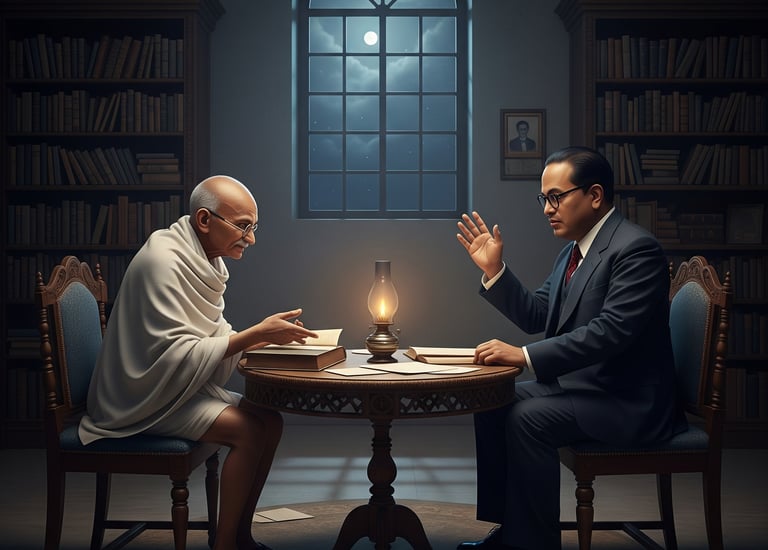The Gandhi-Ambedkar Debate
A major point of deliberation about the socio-cultural landscape of late colonial India was the imagination of multiple interpretations of the nation-state, pitched against the backdrop of electoral dynamics circumscribed around the communal representations of specific minority groups such as the Muslims. The Gandhi-Ambedkar debates over caste, untouchability and the political dimensions of caste reached a flashpoint in 1932, more pronouncedly over the question of whether separate electorates should be offered to the 'untouchables' because they were systematically excluded from the Hindu frameworks and its crucial to recognize their position as a group with distinct socio-political identity (Barua, 25). It can be argued that the friction between Gandhi's and Ambedkar’s socio-political and representational ideologies have often been recast, in contemporary India, on grounds of sharply polarized contrasts by their respective ideological sects, who vociferously denounce each other’s notions of caste and movements aimed at annihilating caste. These disputes have achieved a pivotal position within contemporary literary scholarship in terms of their divergent and multifarious understandings of Gandhi and Ambedkar in the context of the modernist state, constitutional reforms, nationalism, socialism, socialist reconstruction, imperialism, oppression, the forces and nature of caste-based oppression in India and the religious-social complexities affixed with the highly hierarchical structure of caste system. However, it can be argued that Gandhi and Ambedkar sought to decipher the revitalizing impulses of religious ideals but maneuvered with distinct imaginations of the type of polity that would emanate from this social restructuring. As for Gandhi, at the core of this reinvigorated socio-religious whole lies the ideal notion of ‘Varna’, which would be re-envisaged as a system based on the unity and harmonious coexistence of interdependent units. For Ambedkar, in contrast, the vocabulary of Varna is irredeemably contaminated due to its ties with the millennia-old structures of hierarchy, so its employment would fail to imbue a sense of sufficient momentum to break through entrenched circles of oppression. At the heart of the Gandhi-Ambedkar debate lies the intricate connotations of the ‘varna' in their respective philosophical, religious, and social frameworks. As a text with a relatively more certain historical account and comprising a lucid statement of the grounds on which ancient Indian social cartography was concretized, the Purusha Sukta of the Rig Veda has been regarded as the most outstanding record. It narrates the origin of the Varna, when the gods divided Purusha, from the mouth of the divided Purusha came the Brahmin; from the arms, the Rajanya was created; from the thighs came the Vaishya; and from the feet, the Shudra emerged. The Varna system in its etymological uncertainty creates certain lacunas that incite profound debates about the nature of the four-fold varna order. The Varna system was reconfigured by socio-religious and cultural movements such as the Arya Samaj to distill it from the contemporary notions and practices of ‘caste’. Swami Dayanand Saraswati established the samaj in 1875 as he followed the view that numerous castes (Jati) with hereditary occupations should be replaced by the four-fold varna system described in the Vedas. He propagated the view that this revitalization of the Vedic varna arrangement would allow an individual’s position in a specific varna by a closer examination of his/her qualities, actions, and nature monitored by the wise (vidvan). This proposed restructuring of the Varna system occupies a central position within the circles of debates between Ambedkar and Gandhi. This view projects an idealized template for social restructuring whose implementation was riddled with myriad apprehensions and anxieties. For instance, if an individual’s temperament (svabhav) is taken to be unchangeable, the Varna scheme would relegate to the notion of the ascribed caste duties, but if it were alterable, one’s Varna would seemingly change at different intervals across lives. The cardinal contention thus remains whether Varna translates to the contemporary socio-economic differentiations related to practices of caste or the idealized prototype of mutually interacting and interdependent groups. Gandhi’s views on the reconfiguration of the Varna system somewhat aligned with Dayanand Saraswati’s template. Hence, Gandhi envisaged this renovated and structurally altered conceptualization of the Vedic varna system at the heart of his larger conceptualization of ‘Hinduism’. This is reflected in his conscious segregation of the term varna from the lexical register of terms like caste and untouchability. Ambedkar in steep contrast, always denoted varna in terms of its definition as an exclusionary matrix. Thus, the attempts made by the Arya Samaj for him, to speak of Varna and neglecting the enacted caste hierarchies coupled with the structural atrocities were simply a sleight of hand that did not alter the structural inequalities on the ground. This key semantic difference is centered on the grounds of another significant conflict between Gandhi and Ambedkar’s view on the role of inter-dinning and inter-caste marriages in puncturing and annihilating the structures of Caste. While one can observe a shift in Gandhi’s views on this point, somewhere between 1920 and 1945, he broadly argued that these practices were not essential to the cultivation of a democratic spirit. Marriage and social relations are matters of individual choice in the reconstructed Varna system, as per Gandhi. Ambedkar, however, staunchly believed that inter-dining and inter-caste marriages are essential doorways towards deflating the caste system. This shift in temporal registers allowed Ambedkar to think that Gandhi was obscuring the brutal realities of caste discrimination through the subterfuge of Varna even after Gandhi's insistence that his renovated conceptualization of Varna itself was condemned and rejected by Hindu orthodoxy.
Sanya Chandra
7/21/20254 min read
The Gandhi-Ambedkar Debate
A major point of deliberation about the socio-cultural landscape of late colonial India was the imagination of multiple interpretations of the nation-state, pitched against the backdrop of electoral dynamics circumscribed around the communal representations of specific minority groups such as the Muslims. The Gandhi-Ambedkar debates over caste, untouchability and the political dimensions of caste reached a flashpoint in 1932, more pronouncedly over the question of whether separate electorates should be offered to the 'untouchables' because they were systematically excluded from the Hindu frameworks and its crucial to recognize their position as a group with distinct socio-political identity (Barua, 25). It can be argued that the friction between Gandhi's and Ambedkar’s socio-political and representational ideologies have often been recast, in contemporary India, on grounds of sharply polarized contrasts by their respective ideological sects, who vociferously denounce each other’s notions of caste and movements aimed at annihilating caste. These disputes have achieved a pivotal position within contemporary literary scholarship in terms of their divergent and multifarious understandings of Gandhi and Ambedkar in the context of the modernist state, constitutional reforms, nationalism, socialism, socialist reconstruction, imperialism, oppression, the forces and nature of caste-based oppression in India and the religious-social complexities affixed with the highly hierarchical structure of caste system.
However, it can be argued that Gandhi and Ambedkar sought to decipher the revitalizing impulses of religious ideals but maneuvered with distinct imaginations of the type of polity that would emanate from this social restructuring. As for Gandhi, at the core of this reinvigorated socio-religious whole lies the ideal notion of ‘Varna’, which would be re-envisaged as a system based on the unity and harmonious coexistence of interdependent units. For Ambedkar, in contrast, the vocabulary of Varna is irredeemably contaminated due to its ties with the millennia-old structures of hierarchy, so its employment would fail to imbue a sense of sufficient momentum to break through entrenched circles of oppression.
At the heart of the Gandhi-Ambedkar debate lies the intricate connotations of the ‘varna' in their respective philosophical, religious, and social frameworks. As a text with a relatively more certain historical account and comprising a lucid statement of the grounds on which ancient Indian social cartography was concretized, the Purusha Sukta of the Rig Veda has been regarded as the most outstanding record. It narrates the origin of the Varna, when the gods divided Purusha, from the mouth of the divided Purusha came the Brahmin; from the arms, the Rajanya was created; from the thighs came the Vaishya; and from the feet, the Shudra emerged. The Varna system in its etymological uncertainty creates certain lacunas that incite profound debates about the nature of the four-fold varna order. The Varna system was reconfigured by socio-religious and cultural movements such as the Arya Samaj to distill it from the contemporary notions and practices of ‘caste’. Swami Dayanand Saraswati established the samaj in 1875 as he followed the view that numerous castes (Jati) with hereditary occupations should be replaced by the four-fold varna system described in the Vedas. He propagated the view that this revitalization of the Vedic varna arrangement would allow an individual’s position in a specific varna by a closer examination of his/her qualities, actions, and nature monitored by the wise (vidvan).
This proposed restructuring of the Varna system occupies a central position within the circles of debates between Ambedkar and Gandhi. This view projects an idealized template for social restructuring whose implementation was riddled with myriad apprehensions and anxieties. For instance, if an individual’s temperament (svabhav) is taken to be unchangeable, the Varna scheme would relegate to the notion of the ascribed caste duties, but if it were alterable, one’s Varna would seemingly change at different intervals across lives. The cardinal contention thus remains whether Varna translates to the contemporary socio-economic differentiations related to practices of caste or the idealized prototype of mutually interacting and interdependent groups.
Gandhi’s views on the reconfiguration of the Varna system somewhat aligned with Dayanand Saraswati’s template. Hence, Gandhi envisaged this renovated and structurally altered conceptualization of the Vedic varna system at the heart of his larger conceptualization of ‘Hinduism’. This is reflected in his conscious segregation of the term varna from the lexical register of terms like caste and untouchability. Ambedkar in steep contrast, always denoted varna in terms of its definition as an exclusionary matrix. Thus, the attempts made by the Arya Samaj for him, to speak of Varna and neglecting the enacted caste hierarchies coupled with the structural atrocities were simply a sleight of hand that did not alter the structural inequalities on the ground. This key semantic difference is centered on the grounds of another significant conflict between Gandhi and Ambedkar’s view on the role of inter-dinning and inter-caste marriages in puncturing and annihilating the structures of Caste. While one can observe a shift in Gandhi’s views on this point, somewhere between 1920 and 1945, he broadly argued that these practices were not essential to the cultivation of a democratic spirit. Marriage and social relations are matters of individual choice in the reconstructed Varna system, as per Gandhi. Ambedkar, however, staunchly believed that inter-dining and inter-caste marriages are essential doorways towards deflating the caste system. This shift in temporal registers allowed Ambedkar to think that Gandhi was obscuring the brutal realities of caste discrimination through the subterfuge of Varna even after Gandhi's insistence that his renovated conceptualization of Varna itself was condemned and rejected by Hindu orthodoxy.




My post content
